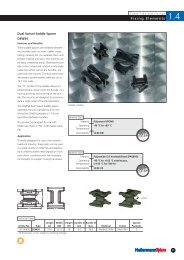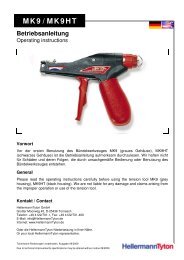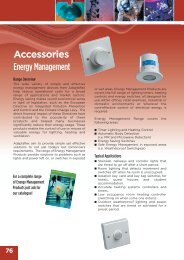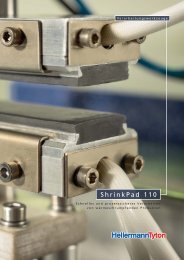please see from page 342. Rapid Overview: - Hellermanntyton
please see from page 342. Rapid Overview: - Hellermanntyton
please see from page 342. Rapid Overview: - Hellermanntyton
You also want an ePaper? Increase the reach of your titles
YUMPU automatically turns print PDFs into web optimized ePapers that Google loves.
Effect of surface energy on<br />
bonding properties<br />
The surface energy (also known as surface<br />
tension) is an important factor in the<br />
selection of the right adhesive. Because of<br />
their chemical formulation, all surfaces<br />
have their own polarity and surface tension.<br />
The cause of surface tensions is the<br />
tendency of liquids to reduce their surface<br />
as far as possible, thus to form drops.<br />
When a surface which is to be marked<br />
(substrate) is wetted with an adhesive, in<br />
addition to the adhesive formulation and<br />
the surface quality (material, roughness,<br />
dampness etc.) the surface energy is also<br />
a decisive factor in the maximum attainable<br />
bonding force of the adhesive.<br />
As a basic rule, it can be noted that the<br />
surface energy of the adhesive must be<br />
less than the surface energy of the<br />
material to be bonded (substrate). The<br />
adhesive should completely wet the substrate<br />
and not form any drops.<br />
The material combination is the decisive<br />
factor<br />
An acrylate-based adhesive is polar and therefore<br />
has a relatively high surface energy.<br />
Acrylate-based adhesives achieve optimum<br />
final bonding on polar substrates (e.g. glass<br />
or metals) with a high surface energy.<br />
More critical is the application of labels<br />
using acrylate-based adhesives on materials<br />
with low surface energy (apolar substrates)<br />
such as, for example, silicone, polyethylene<br />
and polypropylene. The surface tensions of<br />
an acrylate-based adhesive can be reduced<br />
for particular applications by the addition of<br />
specific additives. However, this step brings<br />
with it some drawbacks, for example, a<br />
free-flowing adhesive and thus a limited life<br />
and storage ability of the labels.<br />
The lower bonding force of low-energy surfaces<br />
must therefore be taken into account<br />
of when considering the end use.<br />
Identification Systems<br />
Technical Details for Adhesive Labels<br />
Surface energies of different materials<br />
Material Surface<br />
energy [mN/m]*<br />
Polytetrafluor ethylene (PTFE) 18<br />
Silicon (Si) 24<br />
Polyvinyl fluoride (PVF) 25<br />
Natural rubberPolypropylene (PP) 29<br />
Acryl (PMMA) 31<br />
Epoxy (EP) 36<br />
Polyacetal (POM 36<br />
Polystyrol (PS) 36<br />
Polyvinyl chloride (PVC) 36<br />
Vinylidene chloride (VC) 40<br />
Polyester (PET) 41<br />
Polyimide (PI) 41<br />
Polyarylsulfone (PAS) 41<br />
Phenolic resinPolyurethane (PUR) 43<br />
Polyamide 6 (PA 6) 43<br />
Polycarbonate (PC) 46<br />
Lead (Pb) 450<br />
Aluminium (Al) 840<br />
Copper (Cu) 1100<br />
Chromium (Cr) 2400<br />
Iron (Fe) 2550<br />
* The values stated are non-binding<br />
reference values and for guidance<br />
purposes only.<br />
Rounded drops<br />
• Low surface energy<br />
• Poor wetting<br />
• Weak bonding properties<br />
Flat drops<br />
• High surface energy<br />
• Good wetting<br />
• Good bonding properties<br />
For optimum marking using acrylate-based<br />
adhesive labels, HellermannTyton uses an<br />
improved adhesive formulation, which is coordinated<br />
to the most common materials in<br />
industry. In most cases it is possible to guarantee<br />
very good application of these labels.<br />
In borderline cases, a modified adhesive formulation<br />
may be necessary.<br />
Talk to us, we’ll be delighted to advise<br />
you.<br />
5.3<br />
307
















